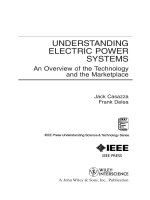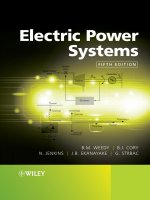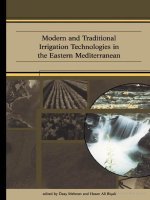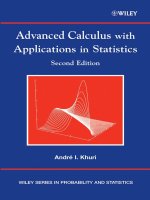Modern Optimization Techniques with Applications in Electric Power Systems pdf
Bạn đang xem bản rút gọn của tài liệu. Xem và tải ngay bản đầy đủ của tài liệu tại đây (5.98 MB, 429 trang )
Energy Systems
Series Editor:
Panos M. Pardalos, University of Florida, USA
For further volumes:
/>Soliman Abdel-Hady Soliman
Abdel-Aal Hassan Mantawy
Modern Optimization
Techniques with
Applications in Electric
Power Systems
Soliman Abdel-Hady Soliman
Department of Electrical
Power and Machines
Misr University for Science
and Technology
6th of October City, Egypt
Abdel-Aal Hassan Mantawy
Department of Electrical
Power and Machines
Ain Shams University
Cairo, Egypt
ISSN 1867-8998 e-ISSN 1867-9005
ISBN 978-1-4614-1751-4 e-ISBN 978-1-4614-1752-1
DOI 10.1007/978-1-4614-1752-1
Springer New York Heidelberg Dordrecht London
Library of Congress Control Number: 2011942262
Mathematics Subject Classification (2010): T25015, T25031, T11014, T11006, T24043
# Springer Science+Business Media, LLC 2012
All rights reserved. This work may not be translated or copied in whole or in part without the written
permission of the publisher (Springer Science+Business Media, LLC, 233 Spring Street, New York,
NY 10013, USA), except for brief excerpts in connection with reviews or scholarly analysis. Use in
connection with any form of information storage and retrieval, electronic adaptation, computer software,
or by similar or dissimilar methodology now known or hereafter developed is forbidden.
The use in this publication of trade names, trademarks, service marks, and similar terms, even if
they are not identified as such, is not to be taken as an expression of opinion as to whether or not they
are subject to proprietary rights.
Printed on acid-free paper
Springer is part of Springer Science+Business Media (www.springer.com)
To the the Spirit of the martyrs of the
EGYPTIAN 25th of January Revolution.
To them we say, “You did what other
generations could not do”. May GOD send
your Spirit to Paradise.
“Think not of those who were killed in
the way of Allah dead, but alive with
their Lord they have provision”
(The Holy Quraan).
To my grandson Ali, the most beautiful
flower in my life.
To my parents, I miss them.
To my wife, Laila, and my kids, Rasha,
Shady, Samia, Hadier, and Ahmad, I love
you all.
To my Great teacher G. S. Christensen
(S.A. Soliman)
To the soul of my parents.
To my wife Mervat.
To my kids Sherouk, Omar, and Kareem.
(A.H. Mantawy)
Preface
The growing interest in the application of artificial intelligenc e (AI) techniques to
power system engineering has introduced the potentials of using this state-of-the-art
technology. AI techniques, unlike strict mathematical methods, have the apparent
ability to adapt to nonlinearities and discontinuities commonly found in power
systems. The best-known algorithms in this class include evolution programming,
genetic algorithms, simulated annealing , tabu search, and neural networks.
In the last three decades many papers on these applications have been published.
Nowadays only a few bo oks are available and they are limited to certain applica-
tions. The power engineering community is in need of a book containing most of
these applications.
This book is unique in its subject, where it presents the application of some
artificial intelligence optimization techniques in electric power system opera tion
and control.
We present, with practical applications and examples, the application of func-
tional analysis, simulated annealing, tabu search, genetic algorithms, and fuzzy
systems on the optimization of power system operation and control.
Chapter 2 briefly explains the mathem atical background behind optimization
techniques used in this book including the minimum norm theorem and how it
could be used as an optimization algorithm; it introduces fuzzy systems, the
simulated annealing algorithm, tabu search algorithm, genetic algorithm, and the
particle swarm as optimization techniques.
Chapter 3 explains the problem of economic operation of electric power sys-
tems, where the problem of short-term operation of a hydrothermal–nuclear power
system is formulated as an optim al problem and using the minimum norm theory to
solve this problem. The problem of fuzzy economic dispatch of all thermal power
systems is also formulated and the algorithm suitable for solution is explained.
Chapter 4 explains the economic dispatch (ED) and unit commitment problems
(UCP). The solution of the UCP problem using artificial intelligence techniques
vii
requires three major steps: a problem statement or system modeling, rules for
generating trial solutions, and an efficient algo rithm for solving the EDP. This
chapter expl ains in detail the different algorithms used to solve the ED and UCP
problems.
Chapter 5, “Optimal Power Flow,” studies the load flow problem and presents
the difference between the conventional load flow and the optimal load flow (OPF)
problem and it introduces the different states used in formulating the OPF as a
multiobjective problem. Furthermore this chapter introduces the particle swarm
optimization algorithm as a tool to solve the optimal power flow problem.
Chapter 6, “Long-Term Operation of Hydroelectric Power Systems,” formulates
the problem of long-term operation of a multireservoir power system connected in
cascade (series). The minimum norm appro ach, the simulated annealing algorithm,
and the tabu search approach are implemented to solve the formulated problem.
Finally, in Chap. 7, “Electric Power Quality Analysis,” presents applications of
the simulated annealing optimization algorithm for measuring voltage flicker mag-
nitude and frequency as well as the harmonic contents of the voltage signal.
Furthermore, the implementation of SAA and tabu search to estimate the frequency,
magnitude, and phase angle of a steady-state voltage signal, for a frequency
relaying application is studied when the signal frequency is constant and is a
variable with time. Two cases are studied: the linear variation of frequency with
time and exponential variation. Effects of the critical parameters on the perfor-
mance of these algorithms are studied in this book.
This book is useful for B. Sc. senior students in the electrical engineering
discipline, MS and PhD students in the same discipline all over the world, electrical
engineers working in utility companies, operation, control, and protection, as well
as researchers working in operations research and water resources research.
Giza, Egypt Soliman Abdel-Hady Soliman
Cairo, Egypt Abdel-Aal Hassan Mantawy
viii Preface
Acknowledgments
I would like to acknowledge the support of the chancellor of Misr University for
Science and Technology, Mr. Khalied Altokhy, and the president of the university
during the course of writing this book. The help of the dean of engineering at Misr
University for Science and Technology, Professor Hamdy Ashour is highly appre-
ciated. Furthermore, I would like to acknowledge Dr. Jamal Madou gh, assistant
professor at the College of Technological Studies, Kuwait, for allowing me to use
some of the materials we coauthored in Chaps. 2 and 3. Finally, my appreciation
goes to my best friend, Dr. Ahmad Al-Kandari, associate professor at the College of
Technological Studies, Kuwait, for supporting me at every stage during the writing
of this book. This book would not be possible without the understanding of my wife
and children.
I would like to express my great appreciation to my wife, Mrs. Laila Mousa for
her help and understanding, my kids Rasha, Shady, Samia, Hadeer, and Ahmad, and
my grandchild, Ali, the most beautiful flower in my life. Ali, I love you so much,
may God keep you healthy and wealthy and keep your beautiful smile for everyone
in your coming life, Amen.
(S.A. Soliman)
I would like to express my deepest thanks to my PhD advisors, Professor Youssef L.
Abdel-Magid and Professor Shokri Selim for their guidance, signs, and friendship,
and allowing me to use some of the materials we coauthored in this book.
I am deeply grateful for the support of Ain Shams Uinversity and King Fahd
Uinversity of Petroleum & Minerals, from which I graduated and continue my
academic career.
Particular thanks go to my friend and coauthor of this book, Professor S. A.
Soliman, for his encouragement and support of this work.
And last, but not least, I would like to thank my wife, Mervat, and my kids,
Sherouk, Omar, and Kareem, for their love, patience, and understanding.
(A.H. Mantawy)
ix
The authors of this book would like to acknowledge the effort done by
Abiramasundari Mahalingam for reviewing this book many times and we appre-
ciate her time, to her we say, you did a good job for us, you were sincere and honest
in every stage of this book.
(The authors)
x Acknowledgments
Contents
1 Introduction 1
1.1 Introduction 1
1.2 Optimization Techniques 2
1.2.1 Conventional Techniques (Classic Methods) 3
1.2.2 Evolutionary Techniques 7
1.3 Outline of the Book 20
References 21
2 Mathematical Optimization Techniques 23
2.1 Introduction 23
2.2 Quadratic Forms 24
2.3 Some Static Optimization Techniques 26
2.3.1 Unconstrained Optimization 27
2.3.2 Constrained Optimization 30
2.4 Pontryagin’s Maximum Principle 37
2.5 Functional Analytic Optimization Technique . 42
2.5.1 Norms 42
2.5.2 Inner Product (Dot Product) 43
2.5.3 Transformations 45
2.5.4 The Minimum Norm Theorem. 46
2.6 Simulated Annealing Algorithm (SAA) 48
2.6.1 Physical Concepts of Simulated Annealing 49
2.6.2 Combinatorial Optimization Problems 50
2.6.3 A General Simulated Annealing Algorithm 50
2.6.4 Cooling Schedules 51
2.6.5 Polynomial-Time Cooling Schedule 51
2.6.6 Kirk’s Cooling Schedule 53
2.7 Tabu Search Algorithm 54
2.7.1 Tabu List Restrictions 54
2.7.2 Aspiration Criteria 55
xi
2.7.3 Stopping Criteria 55
2.7.4 General Tabu Search Algorithm 56
2.8 The Genetic Algorithm (GA) 57
2.8.1 Solution Coding 58
2.8.2 Fitness Function 58
2.8.3 Genetic Algorithms Operators 59
2.8.4 Constraint Handling (Repair Mechanism) 59
2.8.5 A General Genetic Algorithm 60
2.9 Fuzzy Systems 60
2.9.1 Basic Terminology and Definition 64
2.9.2 Support of Fuzzy Set 65
2.9.3 Normality 66
2.9.4 Convexity and Concavity 66
2.9.5 Basic Operations 66
2.10 Particle Swarm Optimization (PSO) Algorithm 71
2.11 Basic Fundamentals of PSO Algorithm 74
2.11.1 General PSO Algorithm 76
References 78
3 Economic Operation of Electric Power Systems 83
3.1 Introduction 83
3.2 A Hydrothermal–Nuclear Power System 84
3.2.1 Problem Formulation 84
3.2.2 The Optimization Procedure 87
3.2.3 The Optimal Solution Using Minimum
Norm Technique 91
3.2.4 A Feasible Multilevel Approach 94
3.2.5 Conclusions and Comments 96
3.3 All-Thermal Power Systems 96
3.3.1 Conventional All-Thermal Power Systems;
Problem Formulation 96
3.3.2 Fuzzy All-Thermal Power Systems;
Problem Formulation 97
3.3.3 Solution Algorithm 105
3.3.4 Examples 105
3.3.5 Conclusion 111
3.4 All-Thermal Power Systems with Fuzzy Load
and Cost Function Parameters 112
3.4.1 Problem Formulation 113
3.4.2 Fuzzy Interval Arithmetic Representation
on Triangular Fuzzy Numbers 123
3.4.3 Fuzzy Arithmetic on Triangular L–R
Representation of Fuzzy Numbers 128
3.4.4 Example 129
xii Contents
3.5 Fuzzy Economical Dispatch Including Losses 145
3.5.1 Problem Formulation 146
3.5.2 Solution Algorithm 164
3.5.3 Simulated Example 165
3.5.4 Conclusion 167
References 183
4 Economic Dispatch (ED) and Unit Commitment Problems
(UCP): Formulation and Solution Algorithms 185
4.1 Introduction 185
4.2 Problem Statement 186
4.3 Rules for Generating Trial Solutions 186
4.4 The Economic Dispatch Problem 186
4.5 The Objective Function 187
4.5.1 The Production Cost 187
4.5.2 The Start-Up Cost 187
4.6 The Constraints 188
4.6.1 System Constraints 188
4.6.2 Unit Constraints 189
4.7 Rules for Generating Trial Solutions 191
4.8 Generating an Initial Solution 193
4.9 An Algorithm for the Economic Dispatch Problem 193
4.9.1 The Economic Dispatch Problem in a Linear
Complementary Form 194
4.9.2 Tableau Size for the Economic
Dispatch Problem 196
4.10 The Simulated Annealing Algorithm (SAA)
for Solving UCP 196
4.10.1 Comparison with Other SAA in the Literature 197
4.10.2 Numerical Examples 198
4.11 Summary and Conclusions 207
4.12 Tabu Search (TS) Algorithm 208
4.12.1 Tabu List (TL) Restrictions 209
4.12.2 Aspiration Level Criteria 212
4.12.3 Stopping Criteria 213
4.12.4 General Tabu Search Algorithm . . . 213
4.12.5 Tabu Search Algorithm for Unit Commitment 215
4.12.6 Tabu List Types for UCP 216
4.12.7 Tabu List Approach for UCP 216
4.12.8 Comparison Among the Different Tabu
Lists Approaches 217
4.12.9 Tabu List Size for UCP 218
4.12.10 Numerical Results of the STSA 218
Contents xiii
4.13 Advanced Tabu Search (ATS) Techniques . . 220
4.13.1 Intermediate-Term Memory 221
4.13.2 Long-Term Memory 222
4.13.3 Strategic Oscillation 222
4.13.4 ATSA for UCP 223
4.13.5 Intermediate-Term Memory Implementation 223
4.13.6 Long-Term Memory Implementation 225
4.13.7 Strategic Oscillation Implementation 226
4.13.8 Numerical Results of the ATSA 226
4.14 Conclusions 230
4.15 Genetic Algorithms for Unit Commitment. . . 231
4.15.1 Solution Coding 232
4.15.2 Fitness Function 232
4.15.3 Genetic Algorithms Operators 233
4.15.4 Constraint Handling (Repair Mechanism) 233
4.15.5 A General Genetic Algorithm 234
4.15.6 Implementation of a Genetic Algorithm
to the UCP 234
4.15.7 Solution Coding 235
4.15.8 Fitness Function 236
4.15.9 Selection of Chromosomes 237
4.15.10 Crossover 237
4.15.11 Mutation 237
4.15.12 Adaptive GA Operators 239
4.15.13 Numerical Examples 239
4.15.14 Summary 244
4.16 Hybrid Algorithms for Unit Commitment . . . 246
4.17 Hybrid of Simulated Annealing and Tabu Search (ST) 246
4.17.1 Tabu Search Part in the ST Algorithm 247
4.17.2 Simulated Annealing Part in the ST Algorithm 248
4.18 Numerical Results of the ST Algorithm 248
4.19 Hybrid of Genetic Algorithms and Tabu Search 251
4.19.1 The Proposed Genetic Tabu (GT) Algorithm 251
4.19.2 Genetic Algorithm as a Part of the GT Algorithm 251
4.19.3 Tabu Search as a Part of the GT Algorithm 253
4.20 Numerical Results of the GT Algorithm 255
4.21 Hybrid of Genetic Algorithms, Simulated Annealing,
and Tabu Search 259
4.21.1 Genetic Algorithm as a Part of the GST Algorithm 261
4.21.2 Tabu Search Part of the GST Algorithm 261
4.21.3 Simulated Annealing as a Part
of the GST Algorithm 263
4.22 Numerical Results of the GST Algorithm 263
4.23 Summary 268
xiv Contents
4.24 Comparisons of the Algorithms for the Unit
Commitment Problem 269
4.24.1 Results of Example 1 269
4.24.2 Results of Example 2 271
4.24.3 Results of Example 3 272
4.24.4 Summary 274
References 274
5 Optimal Power Flow 281
5.1 Introduction 281
5.2 Power Flow Equations 287
5.2.1 Load Buses 288
5.2.2 Voltage Controlled Buses 288
5.2.3 Slack Bus 288
5.3 General OPF Problem Formulations 291
5.3.1 The Objective Functions 292
5.3.2 The Constraints 295
5.3.3 Optimization Algorithms for OPF 297
5.4 Optimal Power Flow Algorithms for Single
Objective Cases 299
5.4.1 Particle Swarm Optimization (PSO) Algorithm
for the OPF Problem 300
5.4.2 The IEEE-30 Bus Power System 301
5.4.3 Active Power Loss Minimization 301
5.4.4 Minimization of Generation Fuel Cost 307
5.4.5 Reactive Power Reserve Maximization 309
5.4.6 Reactive Power Loss Minimization 310
5.4.7 Emission Index Minimization 312
5.4.8 Security Margin Maximization 317
5.5 Comparisons of Different Single Objective Functions 319
5.6 Multiobjective OPF Algorithm 327
5.7 Basic Concept of Multiobjective Analysis . . . 327
5.8 The Proposed Multiobjective OPF Algorithm 329
5.8.1 Multiobjective OPF Formulation 329
5.8.2 General Steps for Solving Multi-Objective
OPF Problem 330
5.9 Generating Nondominated Set 330
5.9.1 Generating techniques 330
5.9.2 Weighting method 332
5.10 Hierarchical Cluster Technique 333
5.11 Conclusions 338
Appendix 339
References 342
Contents xv
6 Long-Term Operation of Hydroelectric Power Systems 347
6.1 Introduction 347
6.2 Problem Formulation 349
6.3 Problem Solution: A Minimum Norm Approach 350
6.3.1 System Modeling. 350
6.3.2 Formulation 351
6.3.3 Optimal Solution 354
6.3.4 Practical Application 356
6.3.5 Comments 356
6.3.6 A Nonlinear Model 357
6.4 Simulated Annealing Algorithm (SAA) 366
6.4.1 Generating Trial Solution (Neighbor) . 367
6.4.2 Details of the SAA for the LTHSP 368
6.4.3 Practical Applications 370
6.4.4 Conclusion 371
6.5 Tabu Search Algorithm 371
6.5.1 Problem Statement 372
6.5.2 TS Method 373
6.5.3 Details of the TSA 373
6.5.4 Step-Size Vector Adjustment 376
6.5.5 Stopping Criteria 376
6.5.6 Numerical Examples 376
6.5.7 Conclusions 378
References 378
7 Electric Power Quality Analysis 381
7.1 Introduction 381
7.2 Simulated Annealing Algorithm (SAA) 384
7.2.1 Testing Simulated Annealing Algorit hm 385
7.2.2 Step-Size Vector Adjustment 385
7.2.3 Cooling Schedule 386
7.3 Flicker Voltage Simulation 386
7.3.1 Problem Formulation 386
7.3.2 Testing the Algorithm for Voltage Flicker 387
7.3.3 Effect of Number of Samples 388
7.3.4 Effects of Sampling Frequency 388
7.4 Harmonics Problem Formulation 388
7.5 Testing the Algorithm for Harmonics 389
7.5.1 Signal with Known Frequency 389
7.5.2 Signal with Unknown Frequency 390
7.6 Conclusions 393
7.7 Steady-State Frequency Estimation 394
7.7.1 A Constant Frequency Model, Problem Formulation 396
7.7.2 Computer Simulation 397
xvi Contents
7.7.3 Harmonic-contaminated Signal 398
7.7.4 Actual Recorded Data 400
7.8 Conclusions 401
7.8.1 A Variable Frequency Model 401
7.8.2 Simulated Example 402
7.8.3 Exponential Decaying Frequency 405
7.9 Conclusions 407
References 407
Index 411
Contents xvii
Introduction
Objectives The primary objectives of this chapter are to
• Provide a broad overview of standard optimization techniques.
• Understand clearly where optimization fits into the problem.
• Be able to formulate a criterion for optimization.
• Know how to simplify a problem to the point at which formal optimization is a
practical proposition.
• Have a sufficient understanding of the theory of optimization to select an
appropriate optimization strategy, and to evaluate the results that it returns.
1.1 Introduction [1–11]
The goal of an optimization problem can be stated as follows. Find the combination
of parameters (independent variables) that optimize a given quantity, possibly
subject to som e restrictions on the allowed parameter ranges. The quantity to be
optimized (maximized or minimized) is termed the objective function; the
parameters that may be changed in the quest for the optimum are called control
or decision variables; the restrictions on allowed parameter values are known as
constraints.
The problem formulation of any optimization problem can be thought of as a
sequence of steps and they are:
1. Choosing design variables (control and state variables)
2. Formulating constraints
3. Formulating objective functions
4. Setting up variable limits
5. Choosing an algorithm to solve the problem
6. Solving the problem to obtain the optimal solution
S.A. Soliman and A.H. Mantawy, Modern Optimization Techniques
with Applications in Electric Power Systems, Energy Systems,
DOI 10.1007/978-1-4614-1752-1_1,
#
Springer Science+Business Media, LLC 2012
1
Decision (control) variables are parameters that are deemed to affect the output
in a significant manner. Selecting the best set of decision variables can sometimes
be a challenge because it is difficult to ascertain which variables affect each specific
behavior in a simulation. Logic determining control flow can also be classified as a
decision variable. The domain of potential values for decision variables is typically
restricted by constraints set by the user.
The optim ization problem may have a single objective function or multi-
objective functions. The multiobjective optimization problem (MOOP; also called
the multicriteria optimization, multiperformance, or vector optimization problem)
can be defined (in words) as the problem of finding a vector of decision variables that
satisfies constraints and optimizes a vector function whose elements represent the
objective functions. These functions form a mathematical description of perfor-
mance criteria that are usually in conflict with each other. Hence, the term optimizes
means finding such a solution that would give the values of all the objective functions
acceptable to the decision maker.
Multiobjective optimization has created immense interest in the engineering
field in the last two decades. Optimization methods are of great importance in
practice, particularly in engineering design, scientific experiments, and business
decision making. Most of the real-world problems involve more than one objective,
making multiple conflicting objectives interesting to solve as multiobjective opti-
mization problems.
1.2 Optimization Techniques
There are many optimization algorithms available to engineers with many methods
appropriate only for certain type of problems. Thus, it is important to be able to
recognize the characteristics of a problem in order to identify an appropriate solution
technique. Within each class of problems there are different minimization methods,
varying in computational requirements, convergence properties, and so on. Optimi-
zation problems are classified according to the mathematical characteristics of the
objective function, the constraints, and the control variables.
Probably the most important characteristic is the nature of the objective function.
These classifications are summarized in Table 1.1.
There are two basic classes of optimization methods accor ding to the type of
solution.
(a) Optimality Criteria
Analytical methods: Once the conditions for an optimal solution are established,
then either:
• A candidate solution is tested to see if it meets the conditions.
• The equations derived from the optimality criteria are solved analytically to
determine the optimal solution.
2 1 Introduction
(b) Search Methods
Numerical methods: An initial trial solution is selected, either using common
sense or at random, and the objective function is evaluated. A move is made to a
new point (second trial solution) and the objective function is evaluated again. If
it is smaller than the value for the first trial solution, it is retained and another
move is made. The process is repeated until the minimum is found.
Search methods are used when:
• The number of variables and constraints is large.
• The problem functions (objective and constraint) are highly nonlinear.
• The problem functions (objective and constraint) are implicit in terms of the
decision/control variables making the evaluation of derivative information
difficult.
Other suggestions for classification of optimization methods are:
1. The first is based on classic methods such as the nonlinear programming
technique, the weights method, and the e-constraints method.
2. The second is based on the evolutionary techniques such as the NPGA method
(niched Pareto genetic algorithm), NSGA (nondominated sorting genetic algo-
rithm), SPEA (strength Pareto evolutionary algori thm), and SPEA2 (improving
strength Pareto evolutionary algorithm).
1.2.1 Conventional Techniques (Classic Methods) [2, 3]
The classic methods present some inconveniences due to the danger of conver-
gence, the long execution time, algorithmi c complexity, and the generation of a
weak number of nondominated solutions. Because of these inconveniences, evolu-
tionary algorithms are more popular, thanks to their faculty to exploit vast amounts
of research and the fact that they don’t require prerecognition of the problem.
Table 1.1 Classification of the objective functions
Characteristic Property Classification
Number of control
variables
One Univariate
More than one Multivariate
Type of control variables Continuous real numbers Continuous
Integers Integer or
discrete
Both continuous real numbers and integers Mixed integer
Problem functions Linear functions of the control variables Linear
Quadratic functions of the control variables Quadratic
Other nonlinear functions of the control variables Nonlinear
Problem formulation Subject to constraints Constrained
Not subject to constraints Unconmstrained
1.2 Optimization Techniques 3
The two elements that most directly affect the success of an optimization
technique are the quantity and domain of decision variables and the objective
function. Identifying the decision variables and the objective function in an optimi-
zation problem often requires familiarity with the available optimization techniques
and awareness of how these techniques interface with the system undergoing
optimization.
The most appropriate method will depend on the type (classification) of problem
to be solved. Some optimization techniques are more computationally expensive
than others and thus the time required to complete an optimization is an important
criterion. The setup time required of an optimization technique can vary by
technique and is dependent on the degree of knowledge required about the problem.
All optimization techniques possess their own internal para meters that must be
tuned to achieve good performances. The time required to tweak these parameters is
part of the setup cost.
Conventional optimization techniques broadly consist of calculus-based,
enumerated, and random techniques. These techniques are based on well-
established theories and work perfectly well for a case wherever applicable. But
there are certain limitations to the above-mentioned methods . For example, the
steepest descent method starts its search from a single point and finally ends up with
an optimal solution. But this method does not ensure that this is the global optimum.
Hence there is ever y possibility of these techniques getting trapped in local optima.
Another great drawback of traditional methods is that they require complete
information of the objective function, its dependence on each variable, and the
nature of the function. They also make assumptions in realizing the function as a
continuous one. All these characteristics of traditional methods make them inappli-
cable to many real-life problems where there is insufficient information on the
mathematical model of the system, parameter dependence, and other such informa-
tion. This calls for unconventional techniques to address many real-life problems.
The optimization methods that are incorporated in the optimal power flow tools
can be classified based on optimization techniques such as
1. Linear programming (LP) based methods
2. Nonlinear programming (NLP) based methods
3. Integer programming (IP) based methods
4. Separable programming (SP) based methods
5. Mixed integer programming (MIP) based methods
Notably, linear programming is recognized as a reliable and robust technique for
solving a wide range of specialized optim ization problems characterized by linear
objectives and linear constraints. Many commercially available power system
optimization packages contain powerful linear programming algorithms for solving
power system problems for both planning and operating engi neers. Linear pro-
gramming has extensions in the simplex method, revised simplex method, and
interior point techniques.
4 1 Introduction
Interior point techniques are based on the Karmarkar algorithm and encompass
variants such as the projection scaling method, dual affine method, primal affine
method, and barrier algorithm.
In the case of nonlinear programming optimization methods, the following
techniques are introduced.
• Sequential quadratic programming (SQP)
• Augmented Lagrangian method
• Generalized reduced gradient method
• Projected augmented Lagrangian
• Successive linear programming (SLP)
• Interior point methods
Sequential quadratic programmin g is a technique for the solution of nonlinearly
constrained problems. The main idea is to obtain a search direction by solving a
quadratic program, that is, a problem with a quadratic objective function and linear
constraints. This approach is a generalization of Newton’s method for uncon-
strained minimization. When solving optimization problems, SQP is not often
used in its simple form. There are two major reasons for this: it is not guaranteed
to converge to a local solution to the optimization problem, and it is expensive.
Gradient-based search methods are a category of optimization techniques that
use the gradient of the objective function to find an optimal solution. Each iteration
of the optimization algorithm adjusts the values of the decision variables so that the
simulation behavior produces a lower objective function value. Each decision
variable is changed by an amount proportionate to the reduction in objective
function value. Gradient-based searches are prone to converging on local minima
because they rely solely on the local values of the objective function in their search.
They are best used on well-behaved systems where there is one clear optimum.
Gradient-based methods will work well in high-dimensional spaces provided these
spaces don’t have local minima. Frequently, additional dimensions make it harder
to guarantee that there are not local minima that could trap the search routine. As a
result, as the dimensions (parameters) of the search space increase, the complexity
of the optimization technique increases.
The benefits of traditional use of gradient-based search techniques are that
computation and setup time are relatively low. However, the drawback is that
global minima are likely to remain undiscovered. Nonlinear optimiza tion problems
with multiple nonlinear constraints are often difficult to solve, because although the
available mathematical theory provides the basic principles for solution, it does not
guarantee convergence to the optimal point. The straightforward application of
augmented Lagrangian techniques to such problems typically results in slow (or
lack of) convergence, and often in failure to achieve the optimal solution.
There are many factors that complicate the use of classical gradient-based
methods including the presence of multiple local minima, the existence of regions
in the design space where the functions are not defined, and the occurrence of an
extremely large number of design variables.
1.2 Optimization Techniques 5
All of these methods suffer from three main problems. First, they may not be
able to provide an optimal solution and usually get stuck at a local optimal. Second,
all these methods are based on the assumption of continuity and differentiability of
the objective function which is not actually allowed in a practical system. Finally,
all these methods cannot be applied with discrete variables.
Classical analytical methods include Lagrangian methods where necessary
conditions known as the Karush–Kuhn–Tucker (KKT) conditions are used to identify
candidate solutions. For n large, these classical methods, because of their combinato-
rial nature, become impractical, and solutions are obtained numerically instead by
means of suitable numerical algorithms. The most important class of these methods is
the so-called gradient-based methods. The most well known of these methods are
various quasi-Newton and conjugate gradient methods for unconstrained problems,
and the penalty function, gradient projection, augmented Lagrangian, and sequential
quadratic programming methods for constrained problems.
Traditionally, different solution approaches have been developed to solve the
different classes of the OPF problem. These methods are nonlinear programming
techniques with very high accuracy, but their execution time is very long and they
cannot be applied to real-time power system operations. Since the introduction of
sequential or successive programming techniques, it has become widely accepted
that successive linear programming algorithms can be used effectively to solve the
optimization problem. In SLP, the original problem is solved by successively
approximating the original problem using Taylor series expansion at the current
operating point and then moving in an optimal direction until the solution converges.
Mixed integer programming is an integer programming used for optimizing
linear functions that are constrained by linear bounds. Quite often, the variables
that are being varied can have only integer value (e.g., in inventory problems where
fractional values such as the number of cars in stock are meaningless). Hence, it is
more appropriate to use integer programming. Mixed integer programming is a type
of integer programming in which not all of the variables to be optimized have
integer values. Due to the linear nature of the objective function it can be expressed
mathematically as
min
X
n
j;k¼1
C
j
X
k
(1.1)
where C is the coefficient matrix and X is the attribute vector of attributes x, , x
n
.
Typically, MIP problems are solved by using branch-and-bound techniques to
increase speed.
Mixed integer programming was found to have the widest application. It was
preferred to routing airline crews and other similar problems that bore a close
resemblance to the problem we had at hand. Fu rthermore, the mathematical rigor
we were looking for was well established. However, as the nature of our problem is
continuous and dynamic we preferred to use either simulated annealing or stochastic
approximation (discussed later).
6 1 Introduction
There is to date no universal method for solving all the optimization problems,
even if restricted to cases where all the functions are analytically known, continu-
ous, and smooth. Many inhibiting difficulties remain when these methods are
applied to real-world problems. Typical optimization difficulties that arise are
that the functions are often very expensive to evaluate. The existence of noise in
the objective and constraint functions, as well as the presence of discontinuities in
the functions, constitute further obstacles in the application of standard and
established methods.
1.2.2 Evolutionary Techniques [4–11]
Recently the advances in computer engineering and the increased complexity of the
power system optimization problem have led to a greater need for and application of
specialized programming techniques for large-scale problems. These include dynamic
programming, Lagrange multiplier methods, heuristic techniques, and evolutionary
techniques such as genetic algorithms. These techniques are often hybridized with
many other intelligent system techniques, including artificial neural networks (ANN),
expert systems (ES), tabu search algorithms (TS), and fuzzy logic (FL).
Many researchers agree that first, having a population of initial solutions
increases the possibility of converging to an optimum solution, and second,
updating the current information of the search strategy from the previous history
is a natural tendency. Accordingly, attempts have been made by researchers to
restructure these standard optimization techniques in order to achieve the two goals
mentioned.
To achieve these two goals, researchers have made concerted efforts in the last
decade to invent novel optimization techniq ues for solving real-world problems,
which have the attributes of memory update and population-based search solutions.
Heuristic searches are one of these novel techniques.
1.2.2.1 Heuristic Search [3]
Several heuristic tools have evolved in the last decade that facilitate solving
optimization problems that were previously difficult or impossible to solve. These
tools include evolutionary com putation, simulated annealing, tabu search, particle
swarm, ant colony, and so on. Reports of applications of each of these tools have
been widely published. Recently, these new heuristic tools have been comb ined
among themselves and with knowledge elements, as well as with more traditional
approaches such as statistical analysis, to solve extremely challenging problems.
Developing solutions with these tools offers two major advantages:
1. Development time is much shorter than when using more traditional approaches.
2. The systems are very robust, being relatively insensitive to noisy and/or missing
data.
1.2 Optimization Techniques 7









